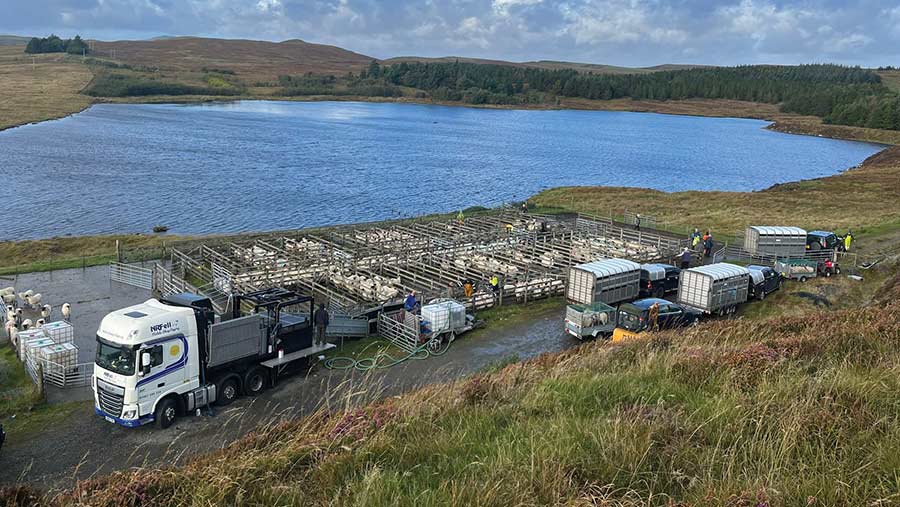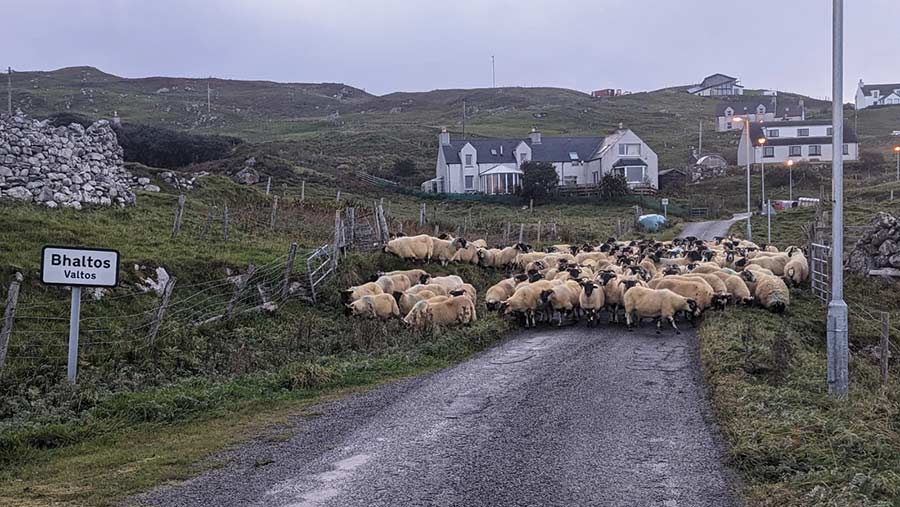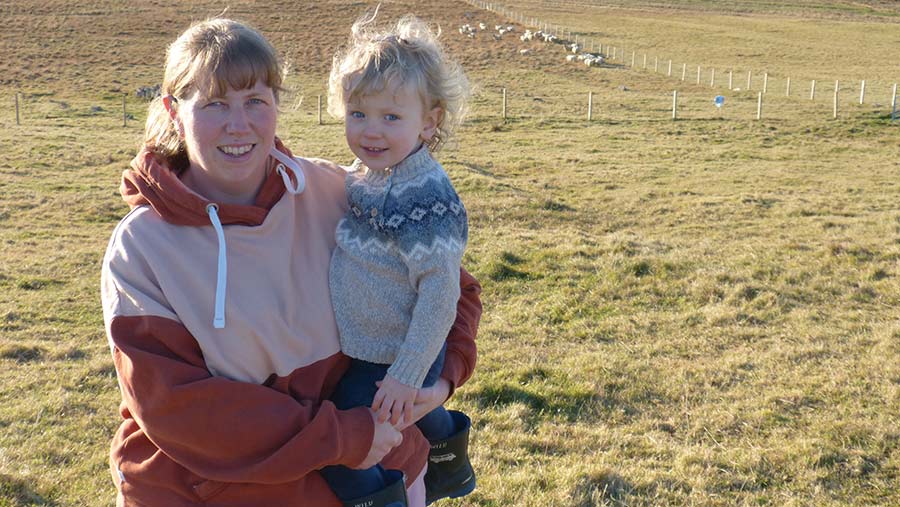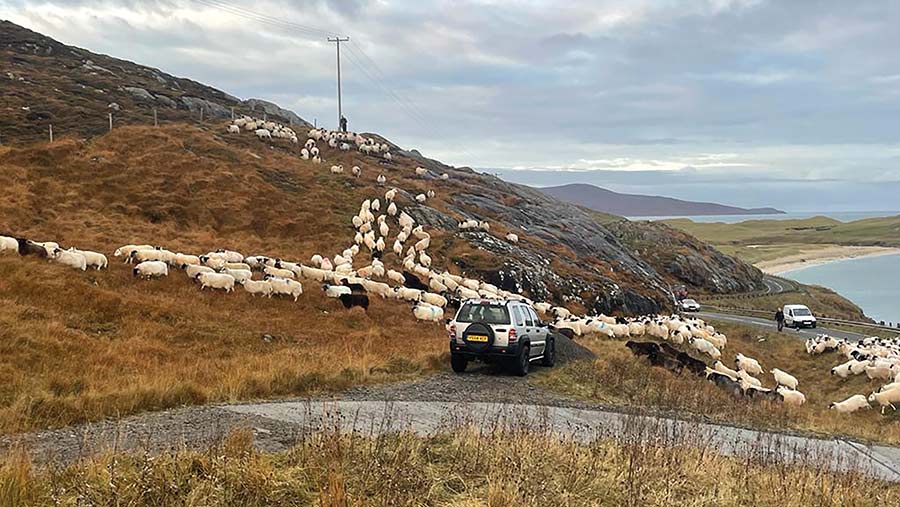Video: Island rallies to dip 28,500 sheep and beat scab
 © Stewart Burgess
© Stewart Burgess More than 28,000 sheep have been dipped to rid a Hebridean island of a costly and contagious parasite.
Crofters and farmers on Lewis and Harris co-ordinated time off, wagons, trailers, and dogs to dip 90% of the island’s flock over 22 days this autumn to combat sheep scab.
Many sheep keepers were shocked when preliminary test reports returned positive for scab.
See also: New sheep dipping guidelines now in place – what to expect
Take a look at the video in full below to hear from leading sheep scab expert Dr Stewart Burgess of the Moredun Research Institute about how the project came to fruition.
Sheep scab
- Caused by the mite psoroptes ovis
- Compulsory dipping was enforced from 1928 to 1992 to control it in the UK
- Re-categorised as a notifiable disease in Scotland in 2010
- Mites live and feed on skin surface, and their faeces causes an allergic reaction
Source: National Animal Disease Information Service
Project outline
The genesis of the project was an educational meeting of the Lewis and Harris Sheep Producers Association (LHSPA) in October 2022, at which leading sheep scab expert Dr Stewart Burgess of the Moredun Research Institute delivered a talk about the parasite.
The following key steps were then taken this year:
- February An annual visit to the island by a scanning contractor, who scans about 11,000 ewes each February, was used as a window of opportunity to test. A total of 105 crofters and groups each volunteered to have 12 ewes tested for sheep scab.
- March Results showed three clinically positive cases (mites on skin scrapings) and blood tests identified a further 17, some of which showed signs of disease.
- Late March Injectable macrocyclic lactones were administered to treat the scab on infected sheep and sheep deemed to be in contact, such as those of neighbouring crofts. Injections were used to minimise stress so close to lambing. Zoetis Animal Health provided a long-acting 2% product (predominantly Cydectin).
- July Follow-up skins and blood tests were conducted on the flocks to see if the problem had been effectively treated.
- September 18,500 sheep were dipped on Lewis in eight days.
- November A further 14 days of dipping in south Lewis and on Harris took place before tupping. This covered more than 10,000 ewes.
- Ongoing The offer to test and treat (with injectables) any breeding sheep or wintering sheep returning to the island was also made.
As an expert consultant overseeing the project, Stewart says he has been blown away by the enthusiasm for flock health on the island.
“It’s been a remarkable undertaking, getting 400-500 different crofts and farms to work together. It’s been a project of people as well as parasites.”

© Stewart Burgess
Dipping logistics
All dipping work was done by an automatic mobile sheep-dipping crate mounted on a truck by Neil Fell, of NR Fell Sheep Dipping, County Durham.
Hundreds of phone calls were made to co-ordinate the crofters to get sheep to dipping sites. And gathers covered thousands of hectares of heather, involving flocks of 10 to 1,000 ewes.
For a dipping site to be successful, the sites must:
- Have a good functional sheep fank (pen)
- Have water supplied (running water or in tanks) to dilute the organophosphate (OP) solution
- Have sufficient intermediate bulk container storage for waste dip, for safe, legal disposal.
Individual dipping days were co-ordinated by the island’s sheep producers association through a network of farmers and crofters, down to regional and parish level.
Because about 40% of the breeding sheep population are pregnancy-scanned in six days each year when sheep scanner Simon Bedwell visits the island, many crofters are used to processing sheep through a race quickly.
However, a dipping truck and handling race take much longer to set up than a scanner, so sheep were taken to one location for dipping where possible.
Some days, work extended to 17 or 18 hours. In keeping with island traditions, there is no work allowed on the Sabbath.
Scanning days could see up to 17 stops in one day, but with the dipping trailer, a maximum of three was more realistic.
Close community
Hannah MacKay, secretary of the LHSPA, crofts at North Bragar. She has used her contacts to orchestrate the project with the help of other crofters.
A Scottish Blackface and Suffolk sheep breeder herself, Hannah says an added benefit of OP dip is that it also controls ticks, which are rife across the island.
She sold 10 rams last year to crofters on the island, and says health assurances are important.
She has based her flock on Auldhouseburn and Crossflatt sires for tight skins, and is now using Drannandow and Merkins sires to improve carcasses for the wether lamb market.
“Historically, we used an injectable to control scab, but this year we dipped through the project,” says Hannah. “People of different crofting townships working together like this could be a first on the island.”

Hannah MacKay and her son Joseph © Michael Priestley
Project support
Costs of gathering, dipping, contractor time and expenses, and a mobile handling race, have been funded by the Scottish government, and the Moredun Research Institute is managing the project.
Crofters contributed 50p a sheep dipped to help with the costs, which is about 40-50% of the typical cost for mainland holdings.
Government funding will continue to cover the cost of the project in 2024. Many islanders think dipping should continue after direct support ends.
Testing finds scab
A surprise came for one Harris crofter when his sheep tested positive for scab this February, as part of the Lewis and Harris sheep scab control project.
Richard MacLennan’s hill flock had a three-year hiatus from dipping due to the rising costs of licences and burdensome legislation.
He says he had not seen active clinical scab in his sheep for 35 years. But since the project started, he has played a key role in organising several dipping days on Harris.
“When my ewes were gathered for scanning in February, they looked fine. I couldn’t see scab and they looked fit,” says Richard. “There were positives and it totally surprised me.”
Richard Maclennan Croft facts: Pairc an t-Srath, Borve, Harris
- 180 breeding ewes
- Scottish Blackface and North Country Cheviot Hill-type sheep
- Selling Blackface and Cheviot rams locally
- 50ha of improved ground
- More than 2,000ha of common grazing on heather hill
- Lambs sold store
- Runs a campsite and catering trailer

Moving sheep on Harris © Norma MacLeod
Controlling what you can
There is little Richard can do about the shallow soils, harsh winds, tough heather hill and haulage costs of living on the island, but scab is something he can control, he explains.
As well as dipping, the flock budget has the breeding tups in a clostridial and pasteurellosis vaccination system. Sheep are dosed for fluke; this year, a rafoxanide product was used.
Lambs are given a bolus and vitamin drench as the hills lack many trace elements.
Concentrate feed costs for Richard’s flock are close to £500/t, and it costs £3 a head to have a store lamb taken to Dingwall on the Scottish mainland for sale.
He says scanning at 115% is considered a very good result. To reduce costs, only twin-bearing ewes on in-bye ground have any hard feed between scanning and lambing.
